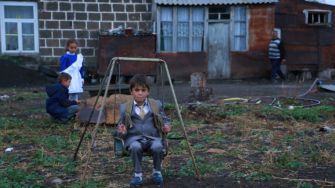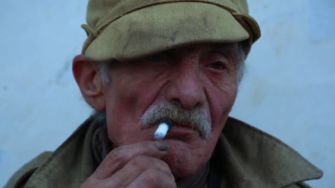“The Trader” is strikingly simple, a paired-down portrait of life. Directed by Tamta Gabrichidze, the 23-minute documentary begins without introduction or background and follows a Georgian (the European country, not the American state) trader whose currency is potatoes and whose wares range from second-hand clothing to graters to toilet paper. Announced as one of Netflix’s original documentary shorts, “The Trader” was picked up for global distribution by the company in early January and released on Feb. 9.
While the trader is the closest character to a protagonist, he is not the center of the documentary. With minimal conversation between subjects and no commentary, the majority of the documentary’s details remain unknown, such as the village locations and the identities of interviewees. The trader himself is no exception. The audience never learns his name or background. Instead, the trader acts as a window through which to witness the lives of his customers: potato farmers, town children and village seniors. Rather than identifying the characters by names, the film focuses on their daily interactions and activities, expanding its portrait of human existence. The anonymity of the characters ensures they are not limited by specific identities, imbuing the film with universal relevance that purveys its potency.

The entirety of the documentary captures two days of the trader’s work as he travels from one nameless village to another. The days blend seamlessly together as the places he visits appear to be one and the same, revealing an experience of the altered pace of life that seems to pervade the Georgian countryside. As potatoes are synonymous with money, harvests, worn hands and wrinkled faces are the tell-tale signs of the passage of time. At the same time, however, while children are seen jumping next to a haystack or playing with a kitten, there don’t appear to be any teenagers, only children and adults, as if that period of youth is a myth, whisked away by the wind that rustles the potato fields.
The genius of “The Trader” is how much it tells with so little. And perhaps this is why it won the Short Film Jury Award at the Sundance Film Festival. Limited dialogue and still, long shots of stark potato fields capture life without distractions of excess or luxury, where the singular purpose is work and work is constant.
The cinematography is arresting, but not in a classical sense. The artfully composed shots of fields and towns are not travel-brochure breathtaking. Rather, the beauty of “The Trader” and its cinematography is in its frank depiction of reality. It’s honest and unembellished, like the conversations between the trader and his customers or the dirt under the nails of the farmers.

The longest visual shots are perhaps the most memorable. A young boy on a short swing, his feet touch the ground, he stares into the camera. An old man on a bench, a worn white building with teal window trimming behind him, a close-up as he smokes.
Life in these rural areas is defined by subsistence. These villages are not in an impoverished country; the frolicking children are in clean, white and blue school uniforms. However, these villages are also not places of thriving economies and overabundance; two boys’ eyes dart around the trader’s minibus of goods like a record skipping as they take stock of the various objects with a famished gaze.
It is Gabrichidze’s bareboned portrait of these lives that makes viewers think without trying too hard. Instead of feeding the audience an agenda or attempting to convey a subject’s reality with statistics or voice over, Gabrichidze’s minimalist storytelling is compelling and thought-provoking without the clutter, leaving analysis open to interpretation. Gabrichidze depicts these towns in neither a patronizing nor sympathetic light, unlike many documentarians who imply a personal agenda within their narrative.
The subject of the documentary is reminiscent of Van Gogh’s masterpiece
“The Potato Eaters.” Van Gogh wanted to convey that the potato eaters ‘have tilled the earth themselves with these hands they are putting in the dish…that they have thus honestly earned their food.’ Both the film and the painting select an unglamorous subject that would otherwise escape audiences’ attention, including the dirt, grit and other details that render the subjects authentically.
Like Van Gogh, Gabrichidze portrays an uncommon and unexpected subject with simple earnestness. In a world consumed by abundance, the lasting value of “The Trader” will be its unadorned depiction of the fundamentals of human existence in a foreign country.






